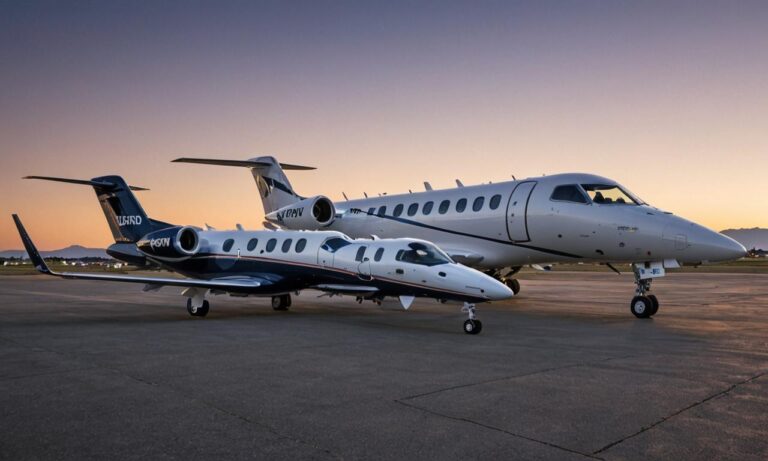When it comes to light business jets, the comparison between the Embraer Phenom 100 and the Honda Jet often arises. Both aircraft represent innovation and sophistication in the aviation industry. Let’s delve into the key features and specifications of each to understand their distinct advantages and capabilities.
Performance and Specifications
The Embraer Phenom 100 boasts impressive performance metrics, including a maximum cruise speed of 390 knots and a range of around 1,178 nautical miles. Powered by Pratt & Whitney PW617F-E engines, it offers excellent fuel efficiency and reliability. With a spacious cabin accommodating up to four passengers, the Phenom 100 provides a comfortable and luxurious travel experience.
On the other hand, the Honda Jet stands out with its innovative over-the-wing engine mount configuration, contributing to reduced drag and enhanced fuel efficiency. It achieves a maximum cruise speed of 420 knots and a range of approximately 1,223 nautical miles. With seating for up to six occupants, including the pilot, the Honda Jet offers a blend of performance and comfort.
Cabin Design and Comfort
Both the Embraer Phenom 100 and the Honda Jet prioritize passenger comfort and convenience. The Phenom 100 features a spacious cabin layout with large windows, allowing ample natural light to illuminate the interior. With ergonomic seating and customizable cabin options, passengers can relax and enjoy the journey.
Similarly, the Honda Jet’s cabin design emphasizes comfort and functionality. The innovative over-the-wing engine mount configuration not only enhances performance but also creates additional cabin space. With a fully equipped galley and advanced entertainment systems, passengers can experience a luxurious flying experience aboard the Honda Jet.
Technology and Innovation
Both aircraft incorporate cutting-edge technology and innovation to deliver exceptional performance and efficiency. The Embraer Phenom 100 features state-of-the-art avionics systems, including the Garmin Prodigy flight deck, providing pilots with advanced navigation and situational awareness capabilities.
Equally impressive, the Honda Jet integrates advanced avionics and fly-by-wire technology for precise control and handling. The Garmin G3000 avionics suite offers intuitive operation and enhanced safety features, ensuring a smooth and enjoyable flight experience.
In conclusion, the comparison between the Embraer Phenom 100 and the Honda Jet highlights the distinct advantages and capabilities of each aircraft. While the Phenom 100 offers exceptional performance and comfort, the Honda Jet stands out with its innovative design and technology.
Ultimately, the choice between the two depends on individual preferences and specific mission requirements. Whether seeking unparalleled performance or luxurious comfort, both the Embraer Phenom 100 and the Honda Jet represent the pinnacle of light business aviation.
Fuel Efficiency and Environmental Considerations
One critical aspect that businesses and individuals consider in light business jets is fuel efficiency and environmental impact. While both the Embraer Phenom 100 and the Honda Jet prioritize efficiency, there are nuances to consider.
The Embraer Phenom 100, powered by Pratt & Whitney PW617F-E engines, is known for its commendable fuel efficiency, contributing to reduced operating costs and environmental footprint. Its engines are designed to meet stringent emissions standards while delivering optimal performance.
Similarly, the Honda Jet’s innovative over-the-wing engine mount configuration not only enhances aerodynamics but also contributes to improved fuel efficiency. The integration of advanced engine technology reflects Honda’s commitment to sustainability and eco-friendly aviation solutions.
Cost of Ownership and Maintenance
Aside from the initial purchase price, the cost of ownership and maintenance is a significant consideration for prospective buyers of light business jets. Understanding the long-term financial implications is crucial in making an informed decision.
The Embraer Phenom 100 is renowned for its low operating costs and relatively straightforward maintenance requirements. Its robust design and reliable engine performance contribute to minimized downtime and efficient servicing.
Similarly, the Honda Jet boasts competitive ownership costs, thanks to its efficient engineering and streamlined maintenance procedures. With a focus on reliability and ease of maintenance, Honda aims to provide owners with a cost-effective ownership experience.
Frequently Asked Questions
| Question | Answer |
|---|---|
| Which jet offers a larger seating capacity? | The Honda Jet typically offers seating for up to six occupants, including the pilot, whereas the Embraer Phenom 100 accommodates up to four passengers. |
| What sets apart the cabin designs of the two jets? | While both jets prioritize comfort, the Honda Jet’s over-the-wing engine mount configuration allows for additional cabin space, enhancing passenger comfort and functionality. |
| What avionics systems are featured in the Embraer Phenom 100? | The Embraer Phenom 100 is equipped with the Garmin Prodigy flight deck, providing pilots with advanced navigation and situational awareness capabilities. |
| How do the fuel efficiency ratings of the two jets compare? | Both the Embraer Phenom 100 and the Honda Jet prioritize fuel efficiency, with their respective engine configurations contributing to reduced operating costs and environmental impact. |






